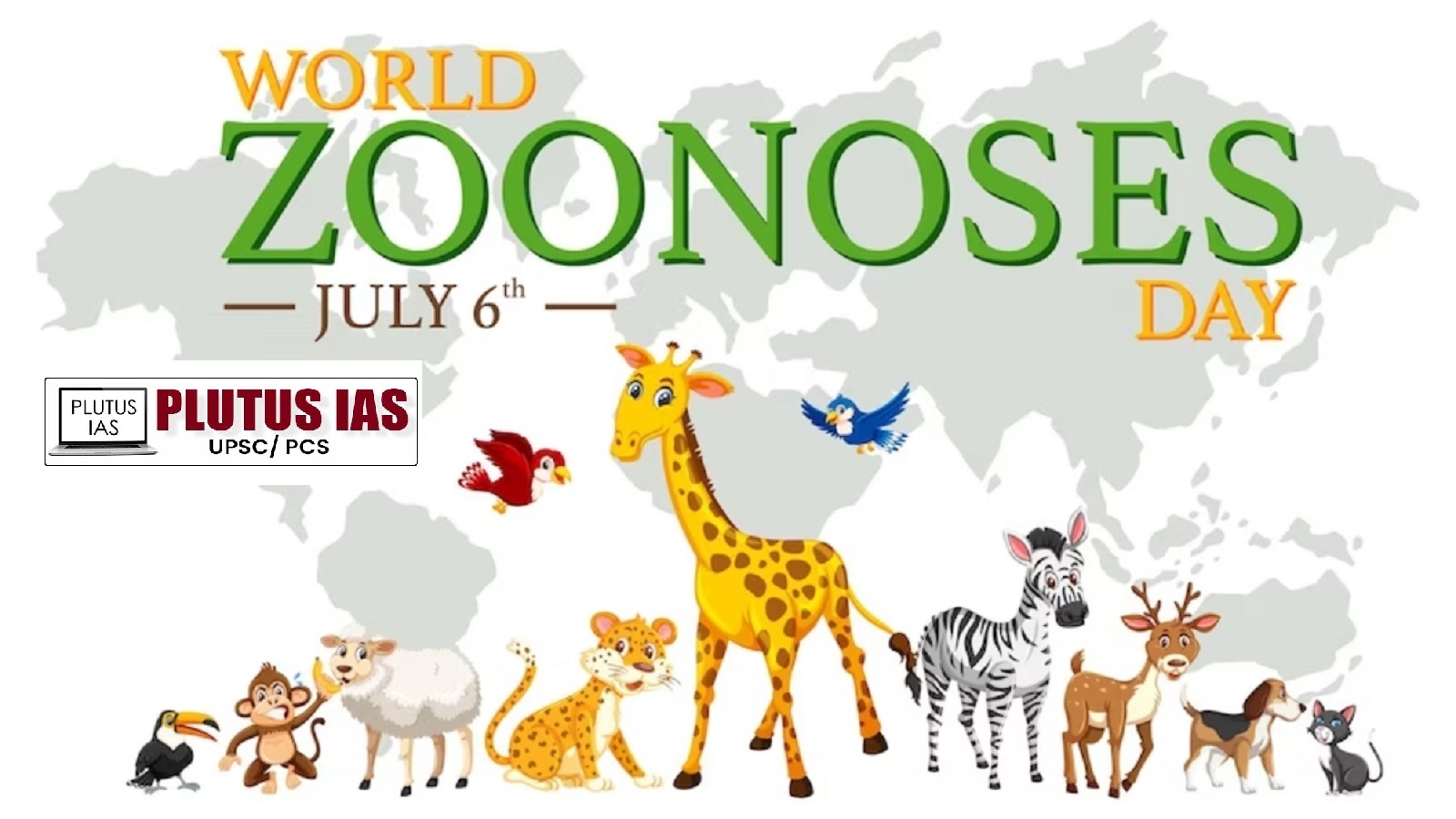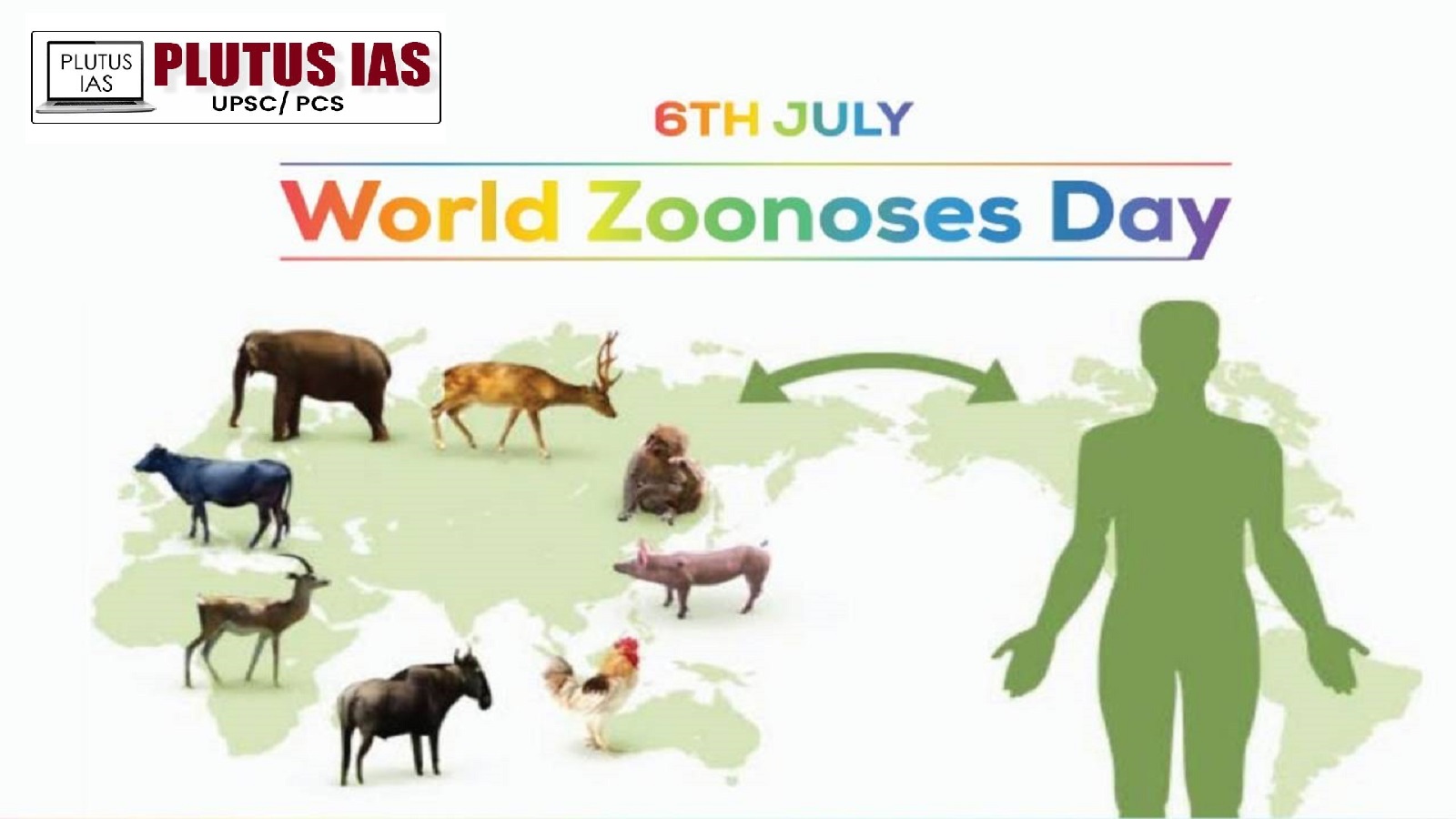10 Jul World Zoonoses Day 2024
( This article is related to the section ‘ Public Health System, Health and Defence Technology of India, Scientific Discovery and Innovation ’ of UPSC Civil Services Mains General Studies Paper-3 and ‘ Central Animal Husbandry and Dairying Department, Louis Pasteur, Zoonotic and Non – Zoonotic Diseases, Public Health, Hygiene and Animal Husbandry Practices, One Health Approach, Vector Control ’ of UPSC Preliminary Exam. It also includes suggestions from the PLUTUS IAS Team. This article is related to ‘ World Zoonoses Day 2024 ’ under ‘ Daily Current Affairs ’.)
Why in the News ?

- Recently the Central Department of Animal Husbandry and Dairying organized an interactive session to commemorate World Zoonoses Day.
- The session was presided over by the Secretary (AHD), Central Animal Husbandry and Dairying Department.
World Zoonoses Day :
- World Zoonoses Day is observed every year on 6 July to raise awareness about zoonosis diseases spread from animals to humans.
- The day is also especially celebrated to honor the achievements of French biologist Louis Pasteur, who developed the first successful rabies vaccine in 1885.
- Zoonosis diseases can be caused by viruses, bacteria, fungi and parasites, and include diseases such as rabies, anthrax, influenza, Nipah, COVID-19, brucellosis and tuberculosis.
Zoonotic and non-zoonotic diseases :
Zoonotic diseases :
- Zoonoses are infectious diseases that can transfer between animals and humans, such as rabies, anthrax, influenza (H1N1 and H5N1), Nipah, COVID-19, brucellosis and tuberculosis.
- These diseases are caused by a variety of pathogens, including bacteria, viruses, parasites, and fungi. However, not all animal diseases are zoonotic.
Non-zoonotic diseases :
- Many diseases affect livestock without posing a risk to human health. These non-zoonotic diseases are species-specific and cannot infect humans. Examples include foot and mouth disease, peste des petits ruminants (PPR), lumpy skin disease, classical swine fever, and Ranikhet disease.
- Approximately 60% of all diseases are zoonotic and 70% of emerging infections originate from animals.
- India accounts for 11% and 18% of global livestock and poultry production respectively. Additionally, India is the largest producer of milk and second largest producer of eggs globally.
Effect of zoonotic diseases :
Zoonotic diseases can have a variety of effects on different regions. Which are as follows –
- Public Health : The spread of zoonotic diseases may lead to increased morbidity and mortality. It has the potential to cause an epidemic.
- Financial : There may also be costs associated with zoonotic diseases, such as those related to health care, animal slaughter, and trade restrictions.
- Social : There may also be fear and stigma associated with zoonotic diseases. Additionally, livelihoods may also be impacted, particularly agriculture and animal husbandry.
Prevention and Control :

The following important measures can be taken for prevention and control of zoonotic diseases –
-
Vaccination :
- A nationwide campaign for Brucella vaccination for bovine calves is being conducted.
- A campaign has also been started under Assistance to States (ASCAD) for rabies vaccination.
-
Sanitary and Animal Husbandry Practices :
- Ensuring good hygiene and proper animal husbandry practices is essential to prevent the spread of diseases.
-
Vector Control :
- Under this, measures are taken to control the vectors spreading the disease and Attention should be paid to measures to control the vectors that spread the disease.
-
One Health Approach :
- Under this, collaborative efforts through One Health approach keeping in mind the interrelationship of human, animal and environmental health are important.
- Under this, collaboration is promoted between veterinarians, medical professionals and environmental scientists so that zoonotic diseases can be comprehensively addressed.
-
To educate and make the public aware :
- Raising awareness between zoonotic and non-zoonotic diseases can reduce undue fear and encourage a more informed approach to animal health and safety.
- Awareness of zoonoses diseases and their control requires public awareness, health education and effective vaccination programs.
Through these measures, the risk of zoonotic diseases can be reduced and a healthy society can be created.
Source – PIB and The Hindu.
Download plutus ias current affairs eng med 10th July 2024
Practice Questions for Preliminary Exam :
Q.1. Consider the following statements regarding World Zoonosis Day.
- Zoonosis is a disease that spreads from animals to humans.
- Control of zoonosis diseases requires public awareness, health education and effective vaccination programs.
- Not all animal diseases are zoonotic diseases.
- Zoonotic diseases can cause epidemics.
Which of the above statement / statements is/are correct?
A. Only 1, 2 and 3.
B. Only 2, 3 and 4.
C. None of these.
D. All of the above .
Answer – D
Practice Questions for Main Exam :
Q.1. Discuss why collaborative efforts and One Health approach are essential to reduce risks associated with zoonotic diseases and ensure a safe environment for all? ( Word Limit – 250 Marks – 15 )




No Comments